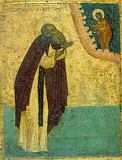

| Previous day | Next day |
| Old Style
April 17
|
Saturday |
New Style
April 30
|
| Bright Week. Fast-free period. | No fast.
|
![]() Hieromartyr Symeon, bishop in Persia, and those with him: Hieromartyrs Abdechalas and Ananias, priests; Martyrs Ustazad and Azat, eunuchs; Fusicus, Ascitrea, and 1,150 others (341).
Hieromartyr Symeon, bishop in Persia, and those with him: Hieromartyrs Abdechalas and Ananias, priests; Martyrs Ustazad and Azat, eunuchs; Fusicus, Ascitrea, and 1,150 others (341). ![]() St. Acacius, bishop of Melitene (ca. 435).
St. Acacius, bishop of Melitene (ca. 435). ![]() St. Zosimas of Solovki (1478).
St. Zosimas of Solovki (1478).
Martyr Adrian of Corinthus in Persia (251). St. Agapitus, pope of Rome (536). Uncovering of the relics of St. Alexander, founder of Svir Monastery (1641). St. Paisius, fool-for-Christ, of Kiev (1893).
New Hieromartyr Michael Novitsky, archpriest, of Uzda (Belorussia) (1935).
Monk-martyr Donnan of Eigg and those with him (Scotland) (618). St. Ephraim the Great, bishop of Atsquri, Georgia (9th c.). St. Macarius of Corinth (1805).
Repose of Hieroschemamonk Constantine of Ekaterinburg (1960).
Thoughts for Each Day of the Year
According to the Daily Church Readings from the Word of God
By St. Theophan the Recluse

Saturday. [Acts 3:11–16; John 3:22–33]
We have two lives, fleshly and spiritual. Our spirit is as though buried in our flesh. Once it begins to extract itself—coming to life by God’s grace—from its intertwining with the flesh and to appear in its spiritual purity, then it will be resurrected, or it will resurrect itself piece by piece. When it wholly tears itself out of this binding, then it comes forth as if from a tomb, in a renewed life. In this manner the spirit becomes separate, alive and active; whereas the tomb of the flesh is separate, dead and inactive, though both are in the same person. This is the mystery of what the apostle says: where the Spirit of the Lord is, there is liberty (II Cor. 3:17). This is liberty from decay, which surrounds our incorruptible spirit; or from passions, corrupting our nature. This spirit, entering into the freedom of the children of God is like a beautifully coloured butterfly, fluttering away from its cocoon. Behold its rainbow colouring: love, joy, peace, longsuffering, gentleness, goodness, faith, meekness, temperance (Gal. 5:22). Is it possible for such a beauty of perfection not to arouse in us a desire to emulate it?
Articles
 Martyr Azades (Azat) the Eunuch of PersiaSaint Azades (Azat) was a wealthy man who served in the household of King Shapur II of Persia, and enjoyed his confidence. |
 St. Acacius the Bishop of MeliteneSaint Acacius, Bishop of Melitene, was born into a pious family in the Armenian city of Melitene. |
 Venerable Zosimas the Abbot of SolovkiSaint Zosimas, Igumen of Solovki a great luminary of the Russian North, was the founder of cenobitic monasticism on Solovki Island. |
 Martyr Adrian of CorinthThe Holy Martyr Adrian suffered during the time of the reign of the emperor Decius (249-251). |
 St. Agapitus the Pope of RomeSaint Agapitus, Bishop of Rome, was a zealous adherent of Orthodoxy. By his pious life he won the general esteem and was elevated to the See of Rome in the year 535. |





